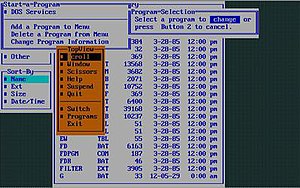TopView

An example of a typical TopView session
|
|
| Developer | IBM Corporation |
|---|---|
| Working state | Discontinued |
| Source model | Closed source |
| Initial release | March 1985 |
| Latest release | 1.12 / April 2, 1987 |
| Marketing target | Business |
| Platforms | x86, (DOS 2.0 - 6.0) |
| Default user interface | Text-based (text mode) |
| License | Proprietary |
TopView is a text-mode PC DOS multitasking, object-oriented windowing environment written by IBM, announced in August 1984 and shipped in March 1985. TopView provided an operating environment that allowed users to run more than one application at the same time on a PC. IBM demonstrated an early version of the product to key customers before making it generally available, around the time they shipped their new PC AT computer.
When Microsoft announced Windows in November 1983, International Business Machines (IBM), Microsoft's important partner in popularizing MS-DOS for the IBM PC, notably did not announce support for the forthcoming window environment. IBM determined that the microcomputer market needed a multitasking environment. When it released TopView in 1985, the press speculated that the software was the start of IBM's plan to increase its control over the IBM PC (even though nothing about the IBM PC was proprietary (including the BIOS which was published to the world)) by creating a proprietary operating system for it, similar to what IBM had offered for years on its larger computers. TopView also allowed IBM to serve customers who were surprised that the new IBM AT did not come with an operating system able to use the hardware multitasking and protected mode features of the new 80286 CPU, as DOS and most applications were still running in 8086/8088 real mode.
Even given TopView's virtual memory management capabilities, hardware limitations still held the new environment back—a base AT with 256 KB of RAM only had room for 80 KB of application code and data in RAM once DOS and TopView had loaded up. 512-640 KB was recommended to load up two typical application programs of the time. This was the maximum the earlier IBM XT could have installed. Once loaded, TopView took back much of the memory consumed by DOS, but still not enough to satisfy industry critics. TopView ran in real mode on any x86 processor and could run well behaved DOS programs (i.e. programs that did not write directly to the screen but used BIOS int 10h and DOS int 21h (such as the IBM Assistant Series of productivity programs)) in an arrangement of windows. Well behaved applications would use standard DOS and BIOS function calls to access system services and hardware. Misbehaving programs (i.e. such as programs that did write directly to the screen) such as Lotus 1-2-3, WordStar and dBase III would still run in the TopView environment, but would consume the entire screen.Object-oriented applications were written using the TopView API. TopView was not updated to make use of the virtual 8086 mode added in the Intel 80386 processors that allowed better virtualization.
...
Wikipedia
